Everyone loves a lush, green, beautiful lawn. However, planting grass seeds and growing grass is not always so easy, especially in clay soil. A little bit of clay on the lawn is not necessarily a bad thing. Clay increases the soil’s water-holding capacity and can be very fertile.
However, excessive clay comes with far more problems than benefits. In this article, you’ll know the best grass for clay soil.
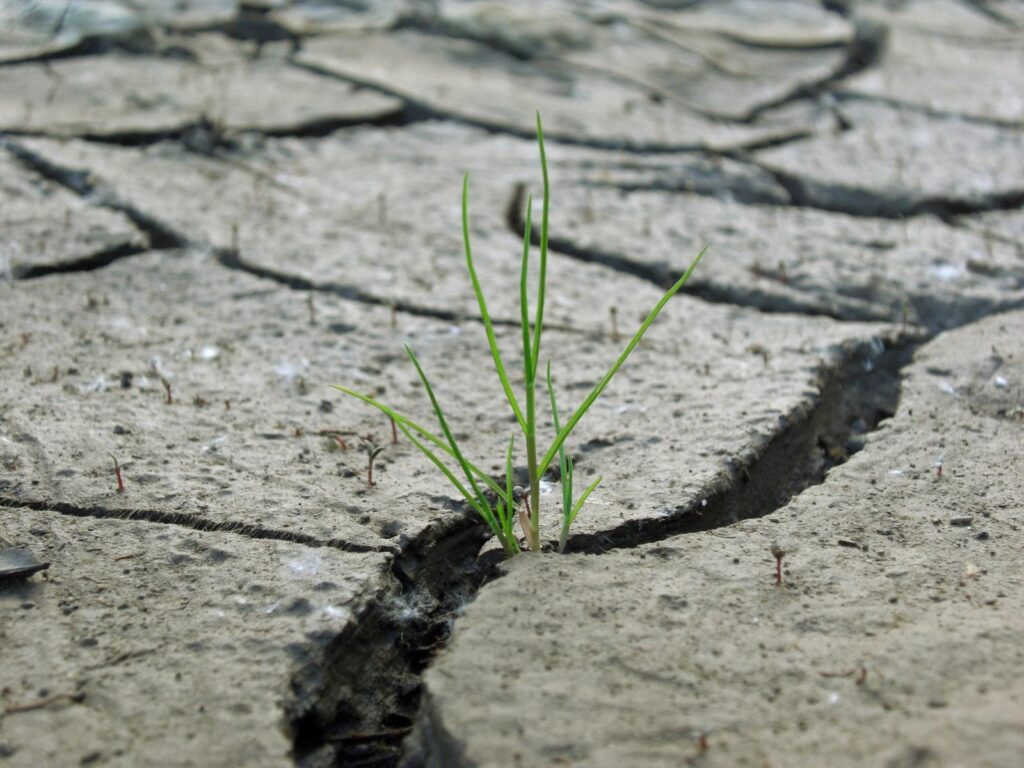
For starters, heavy clay soil requires much less watering than sandy soil.
For instance, clay soil makes it difficult for the grass seeds to establish a robust root system. This reduces the water and nutrient uptake, which results in stunted grass growth. In addition, clay soil also reduces air circulation to the deeper layers of the ground, which is highly detrimental to the grassroots.
So, how do you grow grass on clay? Well, the answer to this question is manifold. You can start by amending clay soil for better grass growth and then choose a grass type that can grow well in heavy clay soils. Many grass types are somewhat clay tolerant and can develop a robust root system even in clay.
Examples include Bermuda grass, Tall fescue grass, and Buffalo grass, etc., but the choice of best grass for clay soil is not that simple. Depending on where you live, you will have to choose either a cool-season grass or a warm-season grass.
You will also have to see if your lawn has access to full sun or if there is partial shade in it.
Properties Of Clay Soils + Issues
Clay soil can be beneficial for the grass growing on your lawn. This is because it contains high amounts of nutrients such as calcium, magnesium, and phosphorus.
However, when too much clay is present in the soil, it tends to mess things up. For instance, clay soil retains much more moisture than other soil types such as silty, loamy and sandy soil. This makes the lawn all muddy and saggy.
In addition to that, many more problems can arise due to the presence of clay soil in your yard. Here’s a list:
- It is a dense soil, and its peculiar soil structure allows it to hold water at the surface. It results in the formation of puddles of standing water on the lawn.
- It dries out slowly which causes the lawn to stay wet. A constantly soggy lawn is a perfect breeding place for the fungus, which comes with its own set of problems.
- It comes with much more compaction issues and forms a hard crust. This results in decreased air circulation, which is not ideal for deep root systems.
All in all, if you are to plant grass seed or overseed an existing lawn containing clay soil, it will be quite challenging. So, let’s go ahead and look at a few grass varieties that can tolerate clay soil and what are some of the most effective ways of improving clay soil.
RELATED: When To Overseed Bermuda Grass: The Best Time And The Dos and Don’ts
Best Grass For Clay Soil
Depending on where you live, the ideal choice of a grass for clay soil will vary from place to place. For example, you will want to choose a warm-season grass in hot weather areas. Whereas, in cooler climates, cool-season grasses such as tall fescue will be the ideal choice.
However, only choosing a grass type that does well in clay soils will not save you. You will also have to put in a proper lawn care plan in place to get your lawn up and running. Nonetheless, here is a list of grasses that do well in clay soil:
Tall Fescue Grass
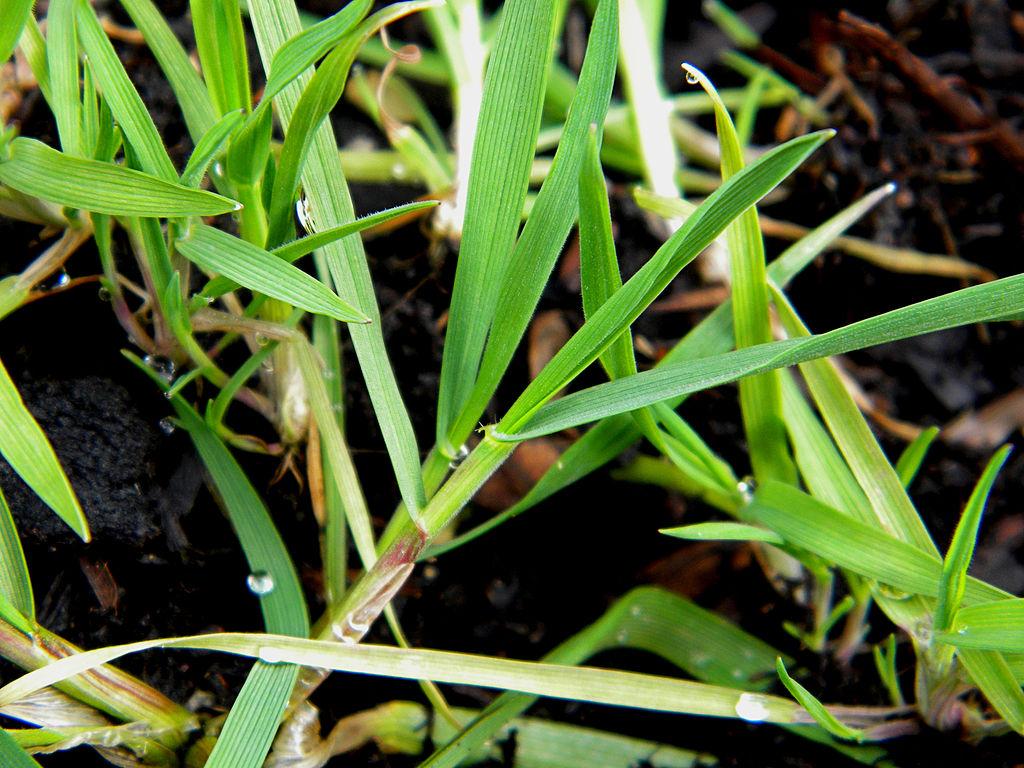
A bunch-type grass that grows in clumps.
It is a cool-season grass species that does very well in clay soil, unlike many other cool-season grasses. Tall fescue grows a deep root system which allows it to counteract the adverse effects of clay soil and soil compaction.
Moreover, some types of fescue grasses, such as creeping red fescue, can grow well in the shade as well. This makes them ideal for areas around buildings and under thick canopies.
Besides the properties mentioned above that make tall fescue good for clay soil, tall fescue can also grow in a wide range of climate conditions. In addition, its heat tolerance is also quite exceptional.
Thus despite being a cool-season grass, tall fescue will keep your lawn lush and green even in summer, unless it gets too hot.
Tall Fescue Quick Facts
| Scientific name | Festuca arundinacea |
| Other names | Kentucky 31 fescue |
| Grass-type | Cool-season, perennial grass |
| Root Depth | Two to three feet deep |
| Shade Tolerance | Tolerates shade better than any other cool-season grass |
| pH range | 5.5 to 7.5 |
| Watering needs | One inch every week |
| Pros | Tolerates compacted, nutrient-poor and acidic soils quite well |
| Cons | – Recovers slowly from injury – Doesn’t tolerate close mowing height – Prone to thinning |
Bermuda Grass
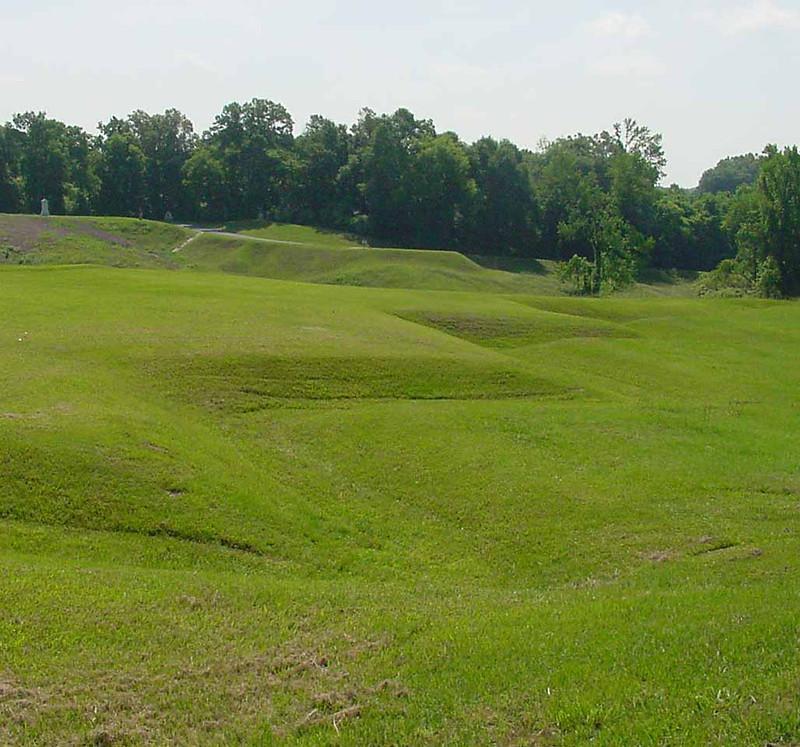
Use Bermuda grass if you want to establish a lush lawn quickly.
Bermuda is another great grass for clay soil. It is a warm-season grass with a deep root system. The network of deep rhizomes makes it quite resilient not only to clay soil but also to drought. In fact, Bermuda is considered the most drought-resistant of all warm-season grasses.
However, common Bermuda grass does not tolerate cold temperatures and goes dormant in cold winters.
Nonetheless, it grows quickly and forms a thick turf; you will have no problem maintaining a lush green lawn. It requires full sun and good drainage conditions. In no way is Bermuda a low-maintenance grass. It will die quickly, if it has to compete with clay soil and poor lawn maintenance conditions at once.
RELATED: Why Is My Grass Turning Yellow And How To Fix It Fast?
Bermuda Grass Quick Facts
| Scientific name | Cynodon dactylon |
| Other names | Dog’s tooth grass, Dhoob, Dubo, Couch grass, Devil’s grass, Bahama grass, Scutch grass, Wire grass, Indian doab |
| Grass-type | Perennial warm-season grass |
| Root Depth | Up to six feet |
| Shade Tolerance | Poorly shade tolerant |
| pH range | 6 to 6.5 |
| Watering needs | 1 to 1.25 inches of water every week |
| Pros | Produces a dense turf and is well adapted to most soils and climate conditions |
| Cons | – Prone to pests and lawn diseases – Grows aggressively, often becoming weedy – Poor cold tolerance |
Buffalo Grass
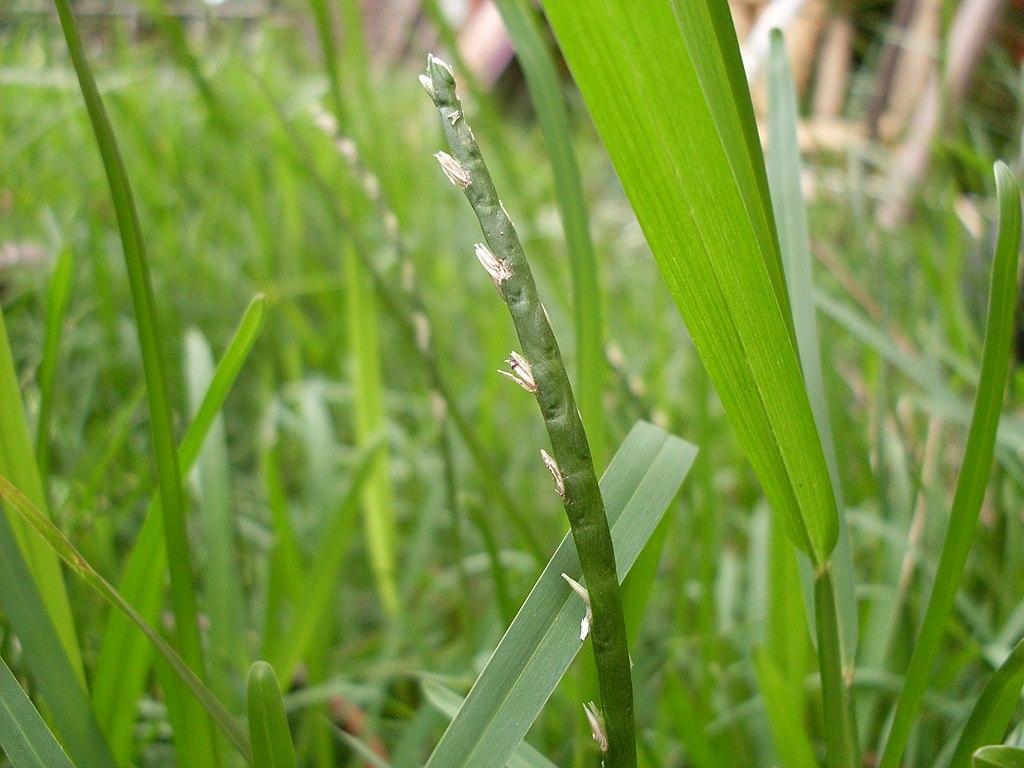
Even if you forget watering grass for a while, it will be okay with Buffalo grass in your lawn.
Buffalo grass is a warm season, low maintenance grass. A buffalo grass lawn can survive with very little water, and the grass spreads extensively via a network of stolons. Buffalo grass is one of the best grass for clay as it also forms a deep root system that allows it to collect enough nutrients and moisture from the ground.
While buffalo grass is considered low maintenance, establishing a buffalo lawn from grass seed is quite tricky.
Also, you might need to mow buffalo grass quite a few times throughout the year because of its aggressive growth. It grows best in warm climates and goes dormant during the cold months. Also, even though the grass needs little water, it can enter dormancy under arid conditions.
Buffalo Grass Quick Facts
| Scientific name | Bouteloua dactyloides |
| Other names | – |
| Grass-type | Perennial, warm-season |
| Root Depth | 12-14 inches deep (30-35 cm) |
| Shade Tolerance | Able to grow in partial shade |
| pH range | 6.0 to 7.5 |
| Watering needs | One to two inches of irrigation every two to four weeks |
| Pros | – Excellent drought and heat tolerance – Tolerant of high traffic – Low maintenance |
| Cons | – Turns green late in summer – Can be expensive – Doesn’t do well in sandy soils – Becomes brown in winter |
Perennial Ryegrass
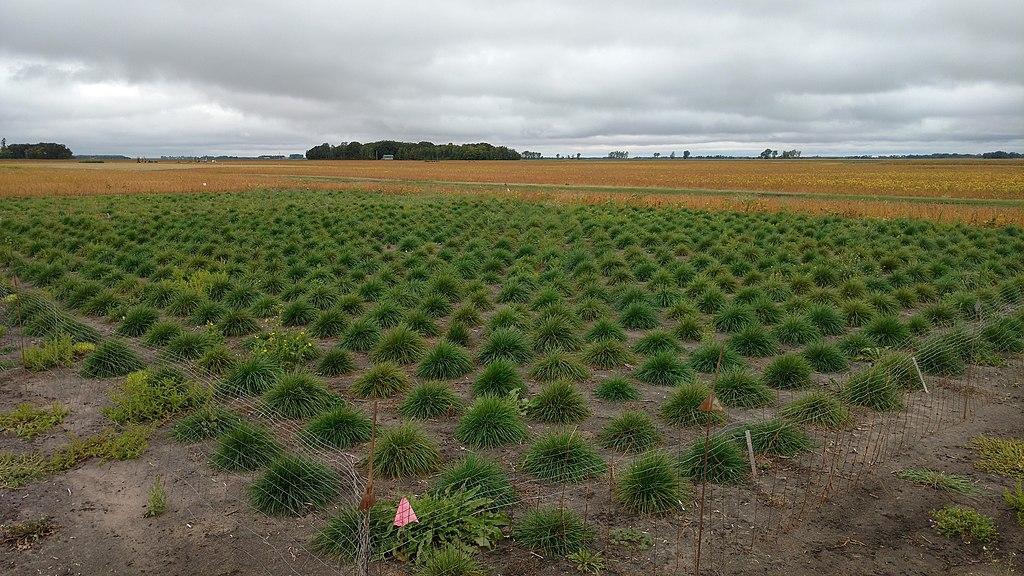
A perennial ryegrass nursery.
Another best grass for clay soil is the perennial ryegrass. Ryegrass lawn can be established either using grass seeds or sod. As compared to other cool-season grasses, it grows rather quickly.
The grass is also used as a forage for grazing animals as it is quite nutritious and recovers from damage very quickly. In addition to home lawns, perennial ryegrass is also used in areas requiring attractive turfs, such as golf courses and pastures.
Like all the other grasses on this list, perennial ryegrass is also suitable for clay soil as it forms an extensive and deep root network. However, perennial ryegrass does not do well in hot weather and drought. It also has a bunch-like growth habit which makes lawn maintenance somewhat tricky.
Perennial Ryegrass Quick Facts
| Scientific name | Lolium perenne |
| Other names | English ryegrass, Ray grass, Winter ryegrass, Italian ryegrass, Lyme grass, Terrell grass, Darnel |
| Grass-type | Perennial, cool season |
| Root Depth | Around 75 cm |
| Shade Tolerance | Withstands but does not grow well in shade |
| pH range | 5.0 to 8.8 |
| Watering needs | Two to three times per week to a depth of around 6 to 12 inches |
| Pros | – Fast seeding and germination growth – Good cold tolerance – Tolerant to high foot traffic – Chokes out weeds easily |
| Cons | – Forms clumps – Costly to maintain – Tough to eradicate if it becomes weedy – Requires a lot of water |
Zoysia Grass

If not controlled, zoysia grass can often become weedy and invasive.
If you have clay soil in your lawn, you can also choose Zoysia. It does very well in the clay soil and is also able to withstand heavy foot traffic, drought and heat really well. However, you should know that, even though Zoysia does well in clay soil, it does not grow well in wet conditions.
So, if you plant zoysia in clay soil, keep aerating your lawn and dethatch as often as necessary so that the moisture does not cause problems.
Zoysia grows best during the summer and spring. It forms a dense, attractive lawn and is very good at choking out most of the weeds itself. In addition to that, Zoysia does not need much mowing as it grows relatively slowly. Zoysia is often planted in areas with high foot traffic, such as parks and sports fields.
Zoysia Quick Facts
| Scientific name | Genus Zoysia |
| Other names | – |
| Grass-type | Perennial, warm-season grass |
| Root Depth | Around 2 inches |
| Shade Tolerance | It can tolerate light shade |
| pH range | 6 to 6.5 |
| Watering needs | – About 1 inch of water weekly – Do not overwater Zoysia grass |
| Pros | – Needs less watering – Fights off weeds quite well on its own – Requires less mowing – Tolerant to drought, heat, and foot traffic |
| Cons | – Prolonged dormancy period – Grass blades are extremely wiry and tough – Crowds out other plants on the lawn |
Kentucky Bluegrass
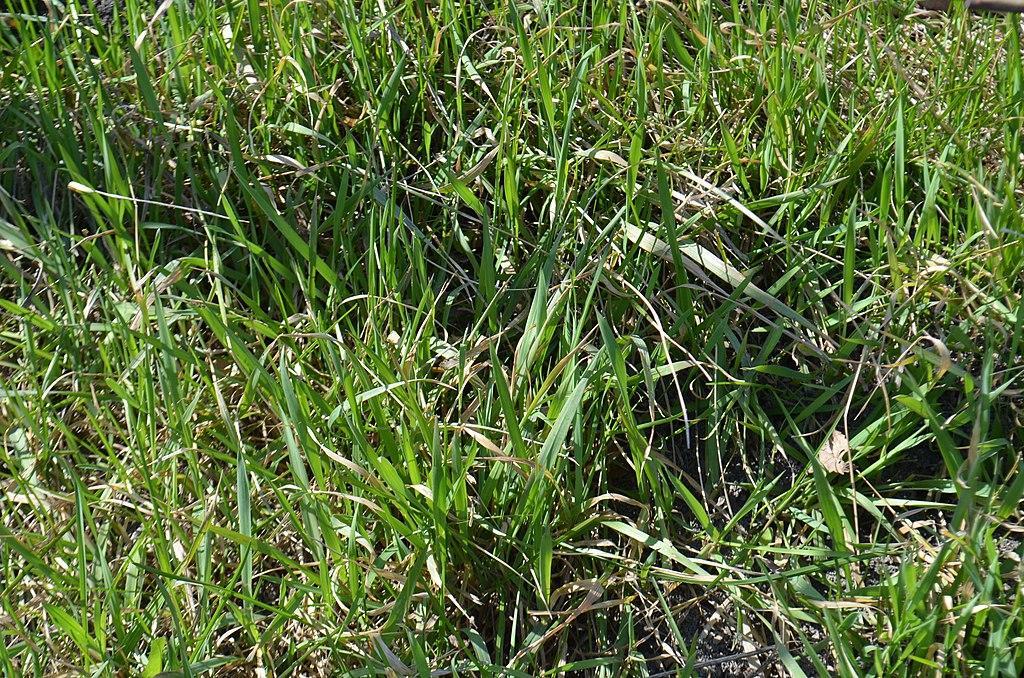
A common lawn grass in northern temperate areas.
It is a short to medium height long-lived grass that has very smooth and soft leaves with a dark green color and boat-shaped tips. The grass grows best in moist and well-drained soils during the cooler months.
Hot weather is the most significant limiting factor for the growth of Kentucky bluegrass. Nonetheless, the grass is favored as it can quickly recover from damage because of its extensive rhizome network.
Also, its dense growth makes it ideal for controlling soil erosion. There are about 100 different cultivars of Kentucky bluegrass available in the market. The grass seeds also come in mixed bags with the grass seeds of other varieties. Mixing grass with other varieties usually results in increased lawn resilience.
Kentucky Bluegrass Quick Facts
| Scientific name | Poa pratensis |
| Other names | Smooth meadow-grass, Common meadow-grass, Blue grass |
| Grass-type | Perennial, cool-season grass |
| Root Depth | 1.5 to 2 feet |
| Shade Tolerance | Poor |
| pH range | 5.5 to 8.5 |
| Watering needs | 2” of water per week |
| Pros | – Spreads fast – Excellent winter hardiness |
| Cons | – Does poorly in shade – Susceptible to fungal infections – Produces excessive thatch |
How Do You Grow Grass On Clay Soil?
You will first need to improve the quality of clay soil and make it more hospitable to the grass in order to establish a lawn in clay soil successfully. Unlike what many people suggest, do not add sand to the clay soil; it can make the situation even worse. Nonetheless, here is how you can grow grass in compacted heavy clay soil:
Aerate the Clay Soil
The first thing you will need to do is core aerate your lawn. It will resolve the compaction issues and create air spaces in the soil, letting water and nutrients move deep into the ground. Adding organic matter to the soil can help with the aeration process as it helps break up the dense, compacted clay soil.
Topdress the Clay Soil
After aerating the lawn, you can top dress the clay soil with an organic matter such as compost or mulch. It helps fill the spaces left by aeration and adds nutrients to the clay soil at the same time. Topdressing with organic material is the best way of introducing nutrients to your clay soil after aeration.
Test and Retest the Soil
Get a soil test for your clay soil. It will give you tons of information about soil chemistry and soil composition. This will help you plan the best treatment for your lawn. Also, once you start treating the clay soil, it is best to perform soil tests repeatedly to see if the treatment methods are giving any fruitful results.
Plant Grass Seed
Following treatment, plant grass seed. Make sure that you choose the best grass seed available in the market that is free of any weed seeds.
Add a Starter Fertilizer
Next, you can add a starter fertilizer to the clay soil. It will help the new grass seed sprout more readily and give them a head start. Starter fertilizers are most beneficial when the grass is planted in wet soils in late fall or early spring.
Water Less Frequently
As already stated, clay soil retains more water. So, in any case, avoid overwatering your grass. Also, we suggest that you water the clay soil early in the morning. This way, any water left standing on the surface of clay soil will evaporate during the day.
Frequently Asked Questions
Can I plant grass seed in clay soil?
Planting grass seeds in clay soil is quite challenging compared to other soil types. However, some types of grasses can grow well in clay soil. So, make sure you choose the best grass seed on the market and choose the grass seed of a species that tolerates clay soil well.
Can you lay sod over clay soil?
Sod roots are often short, and new sod will have difficulty growing in the clay soil. So, make sure that you add organic material to the clay soil and aerate it before sodding. Also, add a top dressing material to the clay soil once you finish sodding.
How do you break down clay soil quickly?
The best way of breaking down clay soil is to use compost or mulches. The organic materials present in compost and mulch will not only help you break down the clay soil, but they will also add valuable nutrients to the clay soil as well.
Sources for Further Reading
- There’s no break for people who garden in clay. Oregon State University Extension Service. (2003). https://extension.oregonstate.edu/news/theres-no-break-people-who-garden-clay
- Gardening in Clay Soils. Utah State University, Yard and Garden Extension. https://extension.usu.edu/yardandgarden/research/gardening-in-clay-soils
- Gardening on Clay Soil. The University of Vermont Extension, Department of Plant and Soil Science. https://pss.uvm.edu/ppp/articles/clay.html
Now that you know the best grass for clay soil, make sure to read our other articles:
How To Revive St. Augustine Grass | Why Is My St. Augustine Dying
How To Make Bermuda Grass Thicker, Greener, and Fuller | A Beginners Guide
St. Augustine Grass Diseases And Problems | What’s Wrong With My St. Augustine?







